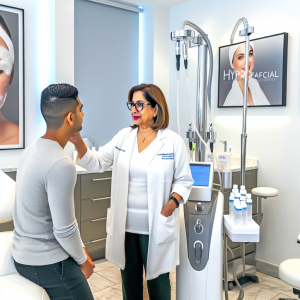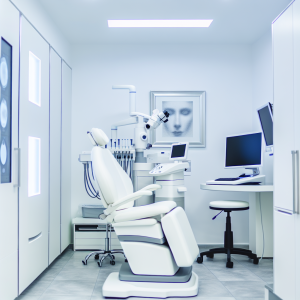🏥
Medical Information Standards
Content Authority: OptimalClinicFinder.com is a comprehensive medical directory platform connecting patients with qualified Botox providers. Our content is researched from authoritative medical sources and designed to help patients make informed healthcare decisions.
How Nabota Works: Clinical Mechanism and Applications
Nabota belongs to the botulinum toxin type A family, functioning through selective blockade of acetylcholine release at neuromuscular junctions. When administered, the purified protein binds to presynaptic nerve terminals, preventing muscle contraction and creating the temporary paralysis that reduces dynamic wrinkles and treats various medical conditions. This mechanism is identical to other botulinum toxin products, but Nabota’s unique purification process may offer enhanced stability and reduced immunogenicity.
The medication’s therapeutic applications extend beyond cosmetic use to include cervical dystonia, blepharospasm, and muscle spasticity management. Clinical research demonstrates that Nabota’s onset of action typically occurs within 3-7 days, with peak effects at 2-4 weeks and duration lasting 3-6 months. The product’s molecular structure and manufacturing process result in minimal protein load, potentially reducing the risk of neutralizing antibody formation compared to first-generation botulinum toxins.
💡
Did You Know?
Clinical studies show that Botox patients achieve excellent results when combined with professional-grade aftercare products.
Clinical Research and Evidence Base for Nabota Botox
The clinical development of Nabota involved multiple large-scale randomized controlled trials, including pivotal studies comparing efficacy to Botox Cosmetic for glabellar lines. These trials enrolled over 1,200 participants across diverse demographics and followed patients for up to 24 weeks post-treatment. Primary endpoint data consistently demonstrated non-inferiority to established botulinum toxin products, with 85-90% of patients achieving significant wrinkle improvement.
Subgroup analyses revealed that Nabota effectiveness extends across different patient populations, including those with varying skin types, ages, and baseline wrinkle severity. The medication showed particular efficacy in patients seeking natural-looking results with minimal downtime. Long-term studies have confirmed safety profiles comparable to other botulinum toxin products, with adverse event rates remaining low across multiple treatment cycles. Recent meta-analyses support Nabota’s position as a viable alternative to traditional Botox treatments.
Treatment Protocols and Clinical Management
Successful Nabota treatment requires careful patient assessment and individualized injection planning. The initial consultation process includes comprehensive facial analysis, muscle movement evaluation, medical history review, and realistic expectation setting. Healthcare providers must assess facial anatomy, identify optimal injection points, and develop treatment plans tailored to patient goals and facial dynamics.
Standard treatment protocols involve precise dosing based on treatment area and patient factors. For glabellar lines, typical dosing ranges from 20-25 units total, distributed across 5 injection points. Forehead treatments generally require 10-20 units, while crow’s feet treatment uses 12-15 units per side. Proper injection technique includes appropriate needle selection, injection depth control, and post-treatment care instructions. Patient education covers expected timeline, activity restrictions, and follow-up scheduling to optimize results and safety.
💡
Quick Tip
Botox works best when combined with healthy lifestyle choices for optimal results.
Safety Profile and Risk Management
The safety profile of Nabota has been extensively characterized through clinical trials and post-marketing surveillance in approved markets. The most common adverse events include injection site pain, temporary bruising, mild headache, and localized swelling, which typically resolve within 24-48 hours. These effects can be minimized through proper injection technique, ice application, and avoiding blood-thinning medications before treatment.
Serious adverse events are rare but include potential systemic spread of toxin effects, resulting in muscle weakness, swallowing difficulties, or breathing problems. These occur in less than 1% of patients and typically result from improper dosing or injection technique. Risk factors for complications include pregnancy, breastfeeding, neuromuscular disorders, and certain medications. Healthcare providers should educate patients about warning signs and establish clear protocols for urgent evaluation when systemic symptoms develop.
Cost Analysis and Access Considerations
The cost of Nabota treatment varies significantly based on geographic location, provider experience, and treatment complexity. Average costs range from $250-650 per treatment session, often 10-20% lower than comparable Botox treatments. This cost advantage stems from competitive pricing strategies and lower manufacturing costs, making botulinum toxin treatments more accessible to broader patient populations.
⚠️
Safety First
Always consult a qualified medical professional before starting Botox. Results vary by individual.
Insurance coverage for Nabota cosmetic treatments is typically not available, as most insurers classify aesthetic procedures as elective. However, when used for medical conditions like cervical dystonia or chronic migraine, coverage may be available through prior authorization processes. Patients should verify coverage details and explore provider financing options, package deals, or loyalty programs that can reduce overall treatment costs while maintaining quality care.
Provider Selection and Treatment Access
Choosing an experienced injector is crucial for optimal Nabota treatment outcomes and safety. Patients should seek board-certified dermatologists, plastic surgeons, or other physicians with extensive botulinum toxin experience and specific Nabota training. Important selection criteria include proper medical credentials, clean facility standards, transparent pricing, and comprehensive consultation processes that include detailed treatment planning.
✓
Why Choose Botox?
●
Clinically proven
●
FDA approved
●
Minimal downtime
●
Long-lasting
Access to Nabota treatments continues expanding as more providers gain experience with the product and regulatory approvals broaden. While currently more limited than traditional Botox availability, qualified providers in major metropolitan areas increasingly offer Nabota as an alternative option. Patients interested in Nabota should research provider credentials, review before-and-after photos, and schedule consultations to discuss treatment goals and expected outcomes before proceeding with treatment.
Comparing Nabota to Traditional Botox Options
Direct comparisons between Nabota and established botulinum toxin products reveal similar efficacy profiles with potential advantages in cost and protein load. Clinical trials demonstrate equivalent wrinkle reduction outcomes, similar onset and duration of effects, and comparable safety profiles. The primary differentiators include pricing, availability, and manufacturing processes that may influence long-term immunogenicity risks.
Patient satisfaction surveys indicate high acceptance rates for Nabota treatments, with most patients reporting natural-looking results and willingness to continue treatment. The lower protein content may theoretically reduce neutralizing antibody formation, potentially maintaining efficacy over multiple treatment cycles. However, long-term comparative studies are still needed to definitively establish any clinical advantages over established products. Patients should discuss these factors with qualified providers to determine the most appropriate botulinum toxin option for their specific needs and goals.
📚 Medical Authorities & Professional Standards
All Botox procedures should be performed by licensed medical professionals following established clinical guidelines and safety protocols.
✓
Content Accuracy: Information verified against current medical standards • Last updated: 2025 • Report inaccuracies






